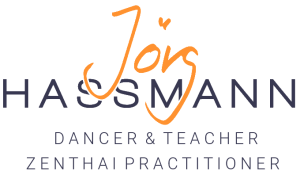The secret of being light
One interest in my dancing is to be light, to not be a burden for my dance partner. Maybe a wish that – even though we are sharing weight – moving for my dance partner doesn’t physically be heavier than moving alone.
I don’t want to know which terrifying aspects of my personality a psycho analist would find in this approach. I love the result of quality in my body, in the connection to my dance partner and in the dance itself. I think it can’t be too wrong.
Being light in a CI duet is only satisfying when there is a strong commitment in the touch and in the communication that happens there. And lightness is only satisfying if gravity is not fought against but used efficiently for momentum.
In the beginning of learning Contact Improvisation it is an important task to give ones own weight. We are scared to give our weight, we don’t want to be too much for our dance partner, we imagine us as being ‘eine Zumutung’ (an imposition). We need to learn ‘uns zuzumuten’. A part of the word ‘Zumutung’ is ‘Mut’ – courage. Courage means to overcome a fear. If we don’t give our weight we mainly give the information that we don’t trust our dance partner. Not a good base for an alive communication. Being carried without being too heavy for someone is an experience from babyhood that we loose on a physical level pretty soon. A part of contact technique is to grow the knowledge how we can give our weight without hurting someone or if possible to even be pleasurable for the partner. That’s how we grow trust.
But there is a common misunderstanding in daring to give weight. Being the person on top giving the weight doesn’t mean to go for the potato sack technique, to just collapse because we are supposed to trust that our partner can take our weight. One basic part of being not too heavy is to listen to the partners body and understand where and in which direction we can give our weight.
But for the secret of being light it is not enough.
A next useful step is to understand that we don’t give full weight when the supporting person changes levels. Only when the bones are aligned in a stable way full weight can be comfortably carried. As the ‘flying’ person it means that I have to be always ready to take part of my own weight again. In the moment of being lifted, when we move to a higher level and the supporter is transitioning his body to a new ‘stable’ position I have a difficult task: I have to give my full weight, so that I can be carried but at the same time I shouldn’t just give my weight downwards and push my partner down. In a way I give my weight while moving upwards myself.
While ‘flying’ I am noticing when the movement curve goes down towards the floor again and I am ready to land in any moment.
Every efficient and organic movement has two counter directions. If I stand and move an arm upwards from hanging to horizontal, my shoulder blade swings downwards and my body moves slightly backwards to counterbalance the weight of the arm.
If I jump upwards my feet extend down into the floor, eventually with the tiptoes until they also leave the ground. But they still reach downwards while my head moves further up. Of course, my toes are also lifted upwards, but their intention or movement direction from the center of my body is downwards.
Being light on top of someone needs a very well timed and placed push downwards into the support. The support is partly the floor and partly the partners body. But the magical thing is, that the intention is ‘upwards’, but in a way that it uses the support. In the developmental movement patterns the push is first. Imagine a baby lying on the belly with its hands on the floor. It pushes with the hands into the floor to help lifting the head. But the intention of the hands is not to push the floor away. The intention is to intensify the connection to the floor. The push happens in a way that the baby’s body understands the support and through that how it can use the support the most efficiently. The movement of the head upwards is a welcome result. If the baby lifts the head without using the hands, it pushes with its belly into the floor. The push is essential. Only lifting the head by itself would be very exhausting (or impossible).
If we think of being light on the way down, we need to be ready for landing. The landing gear (most often the feet) are hanging or reaching down, while the upper body parts (most often the head) is still floating upwards. As soon as the feet touch the floor they are ready to softly take ones own weight, additionally knees and hip joints are happy to fold. Most often we get into a leaning position after a full weight lift. If we are still on top of our partner while and after landing hands and feet need to support our own weight intelligently.
I like the phrase ‘The secret of being light’. It is a real secret I believe. To create it just through pure movement technique wouldn’t work I think. The secret of being light is a paradox intention. It is the intention to always keep the upwards direction. But the upwards intention is built on the knowledge how to use the support from below. Thinking only upwards will create a high and non responsive body tone with a breath that gets stuck after the inhalation – easily accompanied by the wish to be quick and with the result of being restless. Thinking only down in order to give our weight will create a too low body tone that gives up our own responsibility and makes us very heavy.
Being light doesn’t mean to be quick or restless. With being light we might associate being airy or floaty. Maybe a sense of excitement is involved like in flying or being very quick. I think what we are actually looking for and need for a sense of lightness in CI is common timing and shared momentum. For the ‘thinking up’ the ‘support from down’ was essential. Speeding up in a CI situation should be rooted in an inner calmness. The core principles always come in polarities. In the communication necessary for common momentum it needs a calmness to understand one another clearly. Otherwise the connection will become unclear and shaky, which undermines the trust we want to build up. With a focus on being light it needs an extra awareness to the commitment in the touch, the place where the communication is taking place. More precisely the communication happens in the tissues under the touch – first of all the skin. The skin is elastic and able to move in all directions. We need to be able to hear the movement and its directions in the elastic tissues under the touch. This elasticity is the starting point for increasing speed and common momentum. The calmness that we need to listen to the movements under the touch needs to be accompanied by the willingness to not hesitate once an acceleration has started. Common timing and shared momentum are crucial tools for lightness in CI. For bigger and quicker movements we need to have an embodied understanding of the main directions bones and joints are designed for.
But probably all deeply functional things are based on a polarity. Momentum needs the ability to slow down and the calmness inside to not get lost in hysteria. And common momentum needs the knowledge of possible directions of a body provided by bones and joints and the main directions they are designed for. It’s a little devastating to throw such a big and complex thing into the pot with the last sentence of this text. Sorry, it’s a rather complex secret this being-light-thing, I guess.
A tiny last note:
The laws of being light in bodysurfing (rolling together on the floor level) are pretty different to what we do on higher levels. Maybe a topic for another blog entry.


